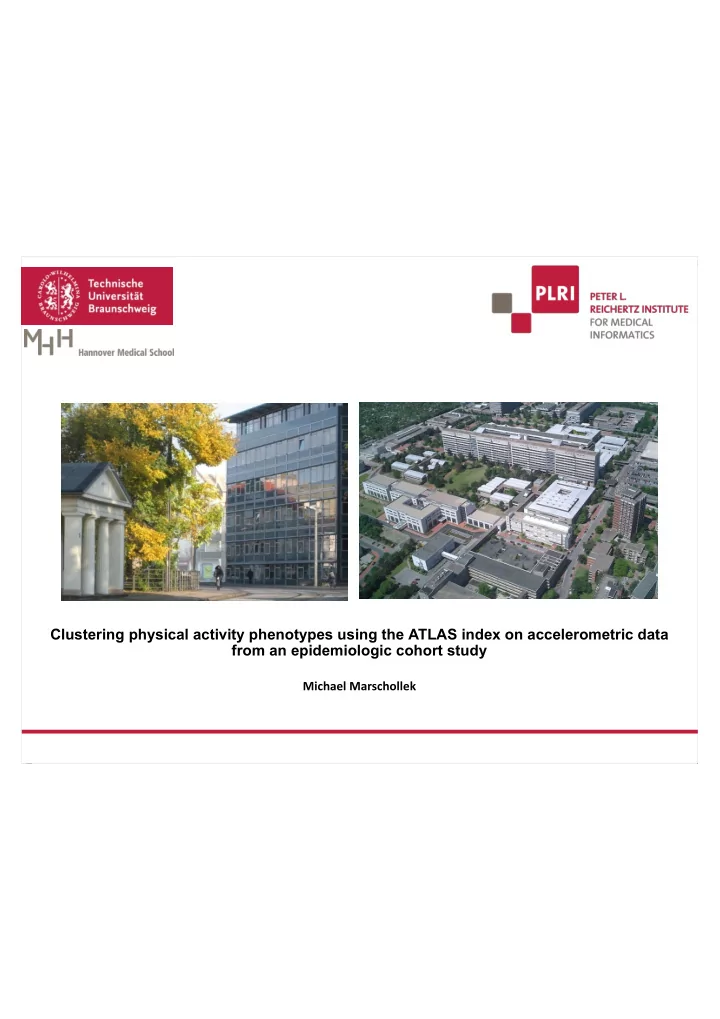

Clustering physical activity phenotypes using the ATLAS index on accelerometric data from an epidemiologic cohort study Michael(Marschollek ! !
Sensors for physical activity (PA) measurement ! ! NIKE Bodymedia AIRUN+ SenseWear Aipermon ! Michael(Marschollek 0
Physical activity measurement in cohort studies ! ! ● NHANES study Ac$Graph AM7164 ● UK Biobank Geneac$v ● Berlin Ageing Study 2 Humo$on/ Xybermind ● and many more … ● Common parameters: active energy expenditure (AEE), sedentary time, number of steps per day, sleep, … ! Michael(Marschollek 06/2/2011 0
Physical activity and health outcome ! ! ● PA is associated with risk of – morbidity (cardiovascular/ musculoskeletal diseases; Sattelmair et al., Circulation, 2011 and Woodcock et al., Int J Epidemiol, 2011 ) and – mortality (e.g. Leitzmann et al., Arch Intern Med, 2007 ) ● Common PA recommendations include – AHA/ ACSM > 5 x per week 30 minutes of moderate PA (3-6 METS) or 3 x per week 20 minutes of vigorous PA (> 6 METS) – WHO > 150/75 minutes of moderate/ vigorous PA, better 300/150 mins. – But: only ca. 3% ‚comply‘ ● Problem: Dose-effect relationships and appropriate patterns remain unclear, as are currently predominant PA patterns and their effects. ● Preliminary work: ATLAS index ( Activity Types from Long-term Accelerometric Sensor data; Marschollek, PLOS One, 2013 ) – PA parameters: 1. intensity, 2. duration, 3. regularity ! Michael(Marschollek 06/2/2011 0
Objective ! ! ● to apply the ATLAS index on a large cohort accelerometer data set to investigate whether physical activity archetypes can actually be extracted and if these match the ones proposed earlier by the author ! Michael(Marschollek 06/2/2011 0
Methods ! ! ● Data set – NHANES (National Health and Nutrition Examination Survey) 2005- 2006, available at: http://www.cdc.gov/nchs/nhanes/nhanes2005- 2006/PAXRAW_D.htm – ActiGraph AM7164 uniaxial accelerometer – N=6386 persons ● Data processing – Splitting the data set into single patient data sets (handling) – PA event detection – Computation of ATLAS index parameters: intensity, duration, regularity – X-Means clustering (Pelleg and Moore, 2000; WEKA‘s x-Means algorithm implementation, Ver 3.6) ! Michael(Marschollek 06/2/2011 0
PA parameter distribution ! ! ! Michael(Marschollek 06/2/2011 0
Clustering results ! ! ! Michael(Marschollek 06/2/2011 0
! ! PA clusters ! ! ● C2 (N=4264): – very low mean activity duration (3.1 per 1000 minutes) – very low intensity and regularity scores (1.09, 0.2) – comprises two thirds of the entire population (N=4264), could be named “insufficiently active”, as proposed by Lee at al ( Am J Epidemiol , 2004) – inactive, sedentary lifestyle ● C4 (N=1892): – fair mean activity duration (28 per 1000 minutes; ca. 40 minutes/day) – higher intensity score (1.23) – low regularity score (0.07) – „irregularly active“ ! Michael(Marschollek 06/2/2011 0
! ! ! PA clusters ! ! ● C1: – low scores for mean activity duration (3.12 per 1000 minutes) and intensity (1.1), but high regularity (3.55) – „busy bee“, constant low-level activity ● C3 (N=72): – mean duration: 200/1000 minutes or 287 minutes/day – intensity level is very high (1.78), and the regularity is low (0.01) – mixed group: „physical worker“ and „weekend warrior“ (?) ! Michael(Marschollek 06/2/2011 0
Discussion ! ! ● method : Identification of distinct PA groups, just using ATLAS parameters computed from accelerometer data, is feasible, and potentially useful for cohort studies (UK Biobank, German National Cohort, etc). ● Short-term activities, such as daily-life low-intensity ones (e.g. a short walk, vacuuming, etc.), can be detected from wearable sensor data using algorithms, and can be associated with health-related outcome parameters. ● The ‚athlete group‘ as proposed earlier (Marschollek, PLOS One, 2013) could not be identified. ● Daily and seasonal PA variations so far are not accounted for ● ToDo: investigate associations between cluster groups and health- related parameters. ! Michael(Marschollek 06/2/2011 0
Outlook ! ! Inter-group comparisons for health outcome parameters (event duration threshold 5 mins, intensity threshold Q20; submitted to Int J Epidemiol ): ● For C-Reactive Protein (CRP) and BMI (but not HDL), ANOVA shows statistically significant differences between the groups 1-4 ● Quartile comparisons e.g. for resting systolic RR (upper [ ≥ 126mmHg] vs. lower [<106mmHg]): – Statistically significant differences for PA duration and regularity ➢ Detecting and denoting low-intensity, short-term activity events is relevant ! Michael(Marschollek 06/2/2011 0
! ! ! Michael(Marschollek 06/2/2011 0
Recommend
More recommend